Nicholas P. Cheremisinoff. Handbook of Solid Waste Management and Waste Minimization Technologies
Подождите немного. Документ загружается.

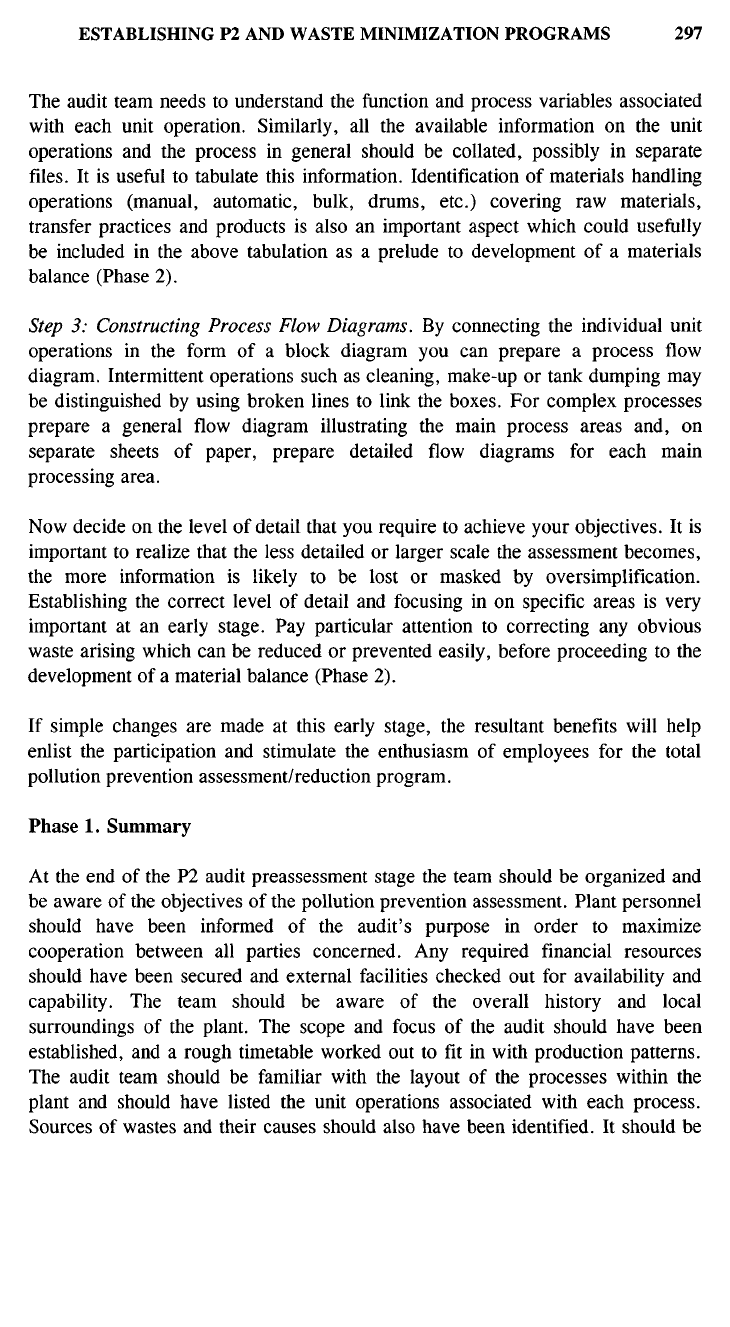
The audit team needs to understand the function and process variables associated
with each unit operation. Similarly, all the available information on the unit
operations and the process in general should be collated, possibly in separate
files.
It is useful to tabulate this information. Identification of materials handling
operations (manual, automatic, bulk, drums, etc.) covering raw materials,
transfer practices and products is also an important aspect which could usefully
be included in the above tabulation as a prelude to development of a materials
balance (Phase 2).
Step 3: Constructing Process Flow Diagrams. By connecting the individual unit
operations in the form of a block diagram you can prepare a process flow
diagram. Intermittent operations such as cleaning, make-up or tank dumping may
be distinguished by using broken lines to link the boxes. For complex processes
prepare a general flow diagram illustrating the main process areas and, on
separate sheets of paper, prepare detailed flow diagrams for each main
processing area.
Now decide on the level of detail that you require to achieve your objectives. It is
important to realize that the less detailed or larger scale the assessment becomes,
the more information is likely to be lost or masked by oversimplification.
Establishing the correct level of detail and focusing in on specific areas is very
important at an early stage. Pay particular attention to correcting any obvious
waste arising which can be reduced or prevented easily, before proceeding to the
development of a material balance (Phase 2).
If simple changes are made at this early stage, the resultant benefits will help
enlist the participation and stimulate the enthusiasm of employees for the total
pollution prevention assessment/reduction program.
Phase 1. Summary
At the end of the P2 audit preassessment stage the team should be organized and
be aware of the objectives of the pollution prevention assessment. Plant personnel
should have been informed of the audit's purpose in order to maximize
cooperation between all parties concerned. Any required financial resources
should have been secured and external facilities checked out for availability and
capability. The team should be aware of the overall history and local
surroundings of the plant. The scope and focus of the audit should have been
established, and a rough timetable worked out to fit in with production patterns.
The audit team should be familiar with the layout of the processes within the
plant and should have listed the unit operations associated with each process.
Sources of wastes and their causes should also have been identified. It should be
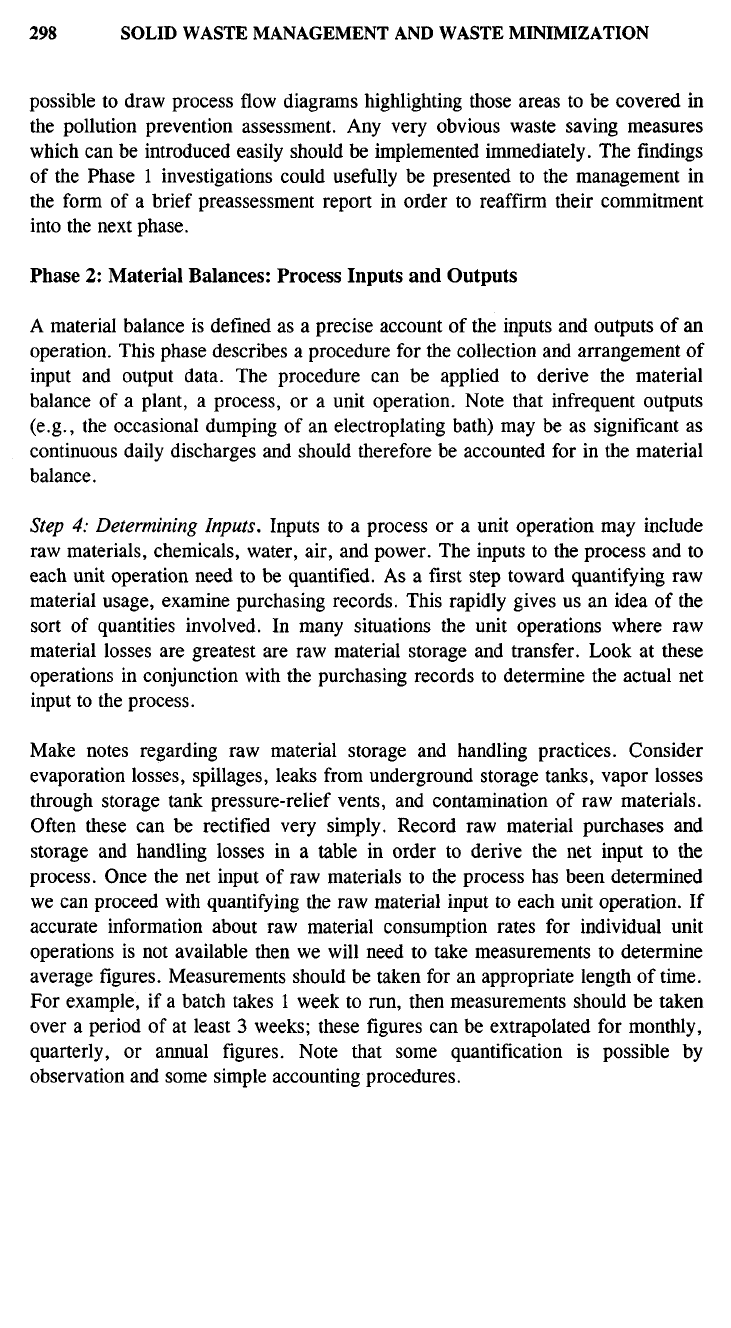
possible to draw process flow diagrams highlighting those areas to be covered in
the pollution prevention assessment. Any very obvious waste saving measures
which can be introduced easily should be implemented immediately. The findings
of the Phase 1 investigations could usefully be presented to the management in
the form of a brief preassessment report in order to reaffirm their commitment
into the next phase.
Phase 2: Material Balances: Process Inputs and Outputs
A material balance is defined as a precise account of the inputs and outputs of an
operation. This phase describes a procedure for the collection and arrangement of
input and output data. The procedure can be applied to derive the material
balance of a plant, a process, or a unit operation. Note that infrequent outputs
(e.g., the occasional dumping of an electroplating bath) may be as significant as
continuous daily discharges and should therefore be accounted for in the material
balance.
Step 4: Determining Inputs. Inputs to a process or a unit operation may include
raw materials, chemicals, water, air, and power. The inputs to the process and to
each unit operation need to be quantified. As a first step toward quantifying raw
material usage, examine purchasing records. This rapidly gives us an idea of the
sort of quantities involved. In many situations the unit operations where raw
material losses are greatest are raw material storage and transfer. Look at these
operations in conjunction with the purchasing records to determine the actual net
input to the process.
Make notes regarding raw material storage and handling practices. Consider
evaporation losses, spillages, leaks from underground storage tanks, vapor losses
through storage tank pressure-relief vents, and contamination of raw materials.
Often these can be rectified very simply. Record raw material purchases and
storage and handling losses in a table in order to derive the net input to the
process. Once the net input of raw materials to the process has been determined
we can proceed with quantifying the raw material input to each unit operation. If
accurate information about raw material consumption rates for individual unit
operations is not available then we will need to take measurements to determine
average figures. Measurements should be taken for an appropriate length of time.
For example, if a batch takes 1 week to run, then measurements should be taken
over a period of at least 3 weeks; these figures can be extrapolated for monthly,
quarterly, or annual figures. Note that some quantification is possible by
observation and some simple accounting procedures.
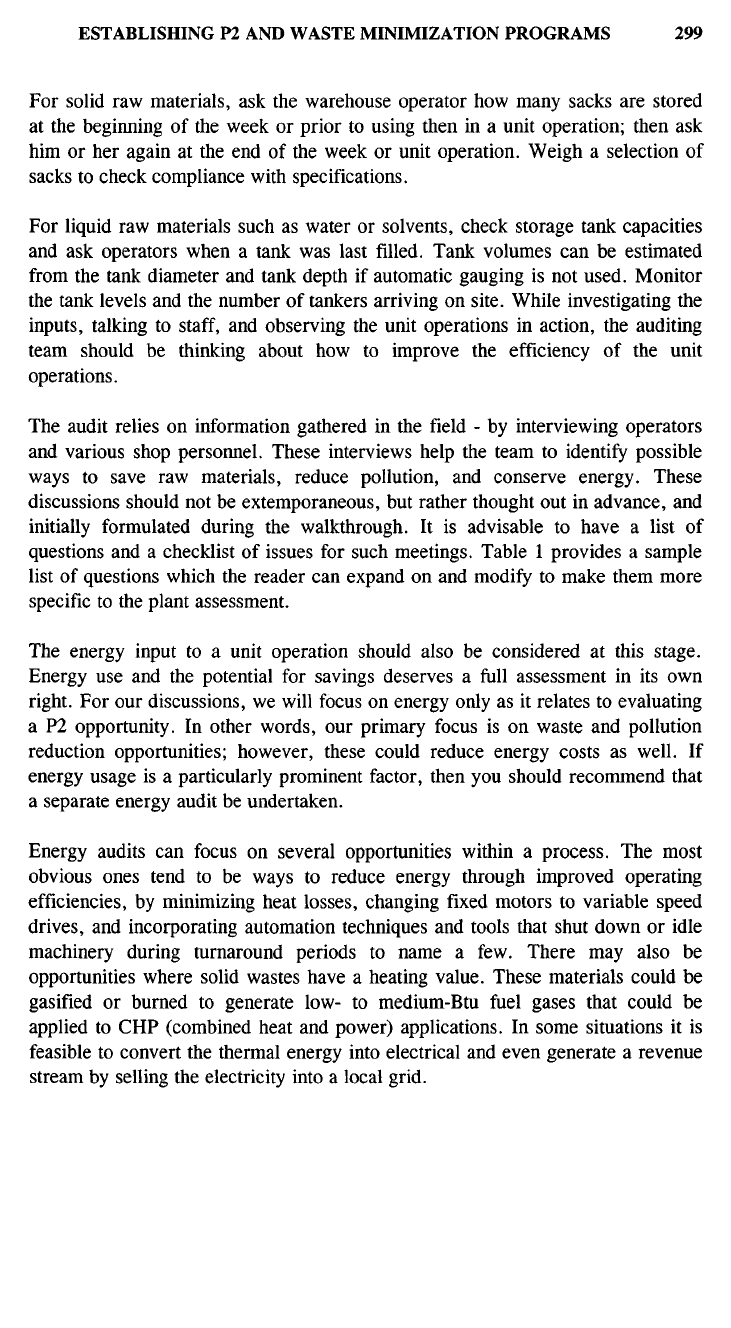
For solid raw materials, ask the warehouse operator how many sacks are stored
at the beginning of the week or prior to using then in a unit operation; then ask
him or her again at the end of the week or unit operation. Weigh a selection of
sacks to check compliance with specifications.
For liquid raw materials such as water or solvents, check storage tank capacities
and ask operators when a tank was last filled. Tank volumes can be estimated
from the tank diameter and tank depth if automatic gauging is not used. Monitor
the tank levels and the number of tankers arriving on site. While investigating the
inputs, talking to
staff,
and observing the unit operations in action, the auditing
team should be thinking about how to improve the efficiency of the unit
operations.
The audit relies on information gathered in the field - by interviewing operators
and various shop personnel. These interviews help the team to identify possible
ways to save raw materials, reduce pollution, and conserve energy. These
discussions should not be extemporaneous, but rather thought out in advance, and
initially formulated during the walkthrough. It is advisable to have a list of
questions and a checklist of issues for such meetings. Table 1 provides a sample
list of questions which the reader can expand on and modify to make them more
specific to the plant assessment.
The energy input to a unit operation should also be considered at this stage.
Energy use and the potential for savings deserves a full assessment in its own
right. For our discussions, we will focus on energy only as it relates to evaluating
a P2 opportunity. In other words, our primary focus is on waste and pollution
reduction opportunities; however, these could reduce energy costs as well. If
energy usage is a particularly prominent factor, then you should recommend that
a separate energy audit be undertaken.
Energy audits can focus on several opportunities within a process. The most
obvious ones tend to be ways to reduce energy through improved operating
efficiencies, by minimizing heat losses, changing fixed motors to variable speed
drives, and incorporating automation techniques and tools that shut down or idle
machinery during turnaround periods to name a few. There may also be
opportunities where solid wastes have a heating value. These materials could be
gasified or burned to generate low- to medium-Btu fuel gases that could be
applied to CHP (combined heat and power) applications. In some situations it is
feasible to convert the thermal energy into electrical and even generate a revenue
stream by selling the electricity into a local grid.
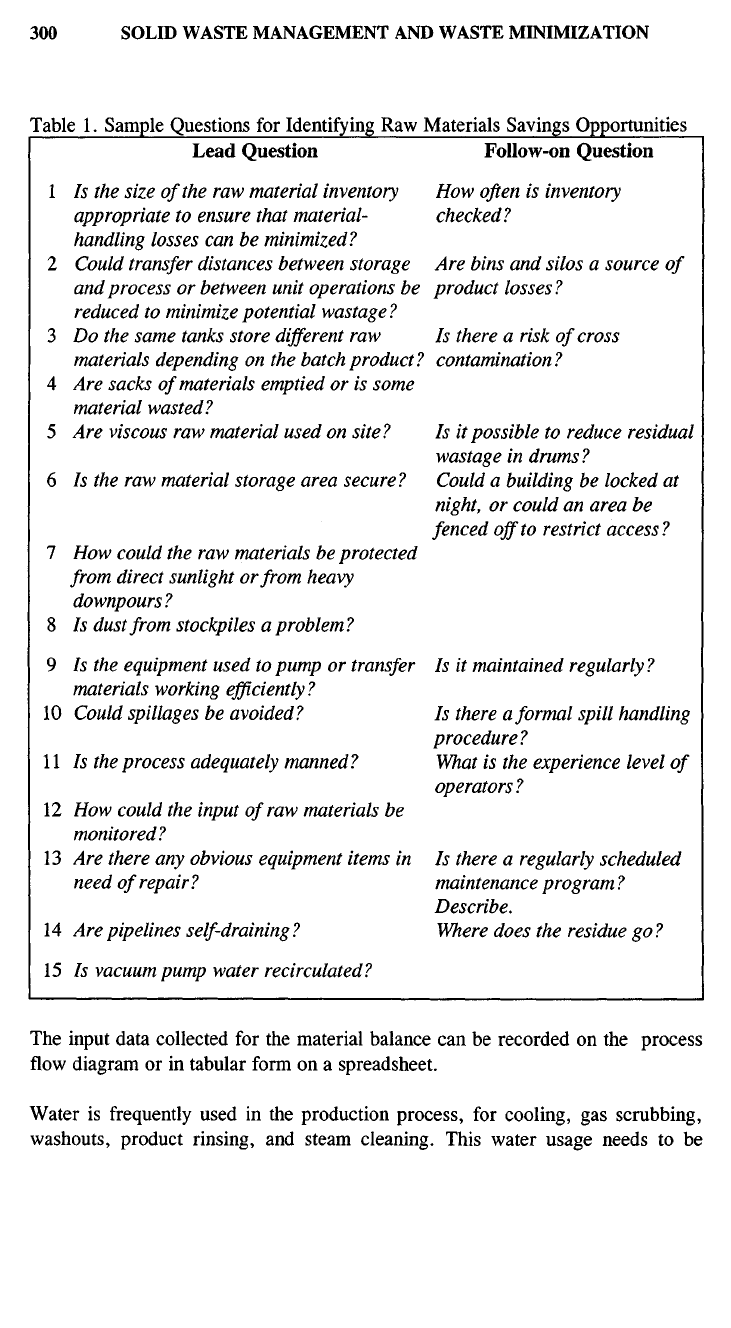
Table 1. Sample Questions for Identifying Raw Materials Savings Opportunities
Lead Question
1 Zs the size of the raw material inventory
appropriate to ensure that material-
handling losses can be minimized?
2 Could transfer distances between storage
and process or between unit operations be
reduced to minimize potential wastage?
3 Do the same tanks store different raw
materials depending on the batch product?
4 Are sacks of materials emptied or is some
material wasted?
5 Are viscous raw material used on site?
6 Is the raw material storage area secure?
7 How could the raw materials be protected
from direct sunlight or from heavy
downpours?
8 Is dust from stockpiles a problem ?
9 Is the equipment used to pump or transfer
materials working efficiently?
10 Could spillages be avoided?
11 Is the process adequately manned?
12 How could the input of raw materials be
monitored?
13 Are there any obvious equipment items in
need of repair?
14 Are pipelines self-draining?
15 Is vacuum pump water recirculated?
Follow-on Question
How often is inventory
checked?
Are bins and silos a source of
product losses?
Is there a risk of cross
contamination?
Is it possible to reduce residual
wastage in drums?
Could a building be locked at
night, or could an area be
fenced off to restrict access?
Is it maintained regularly ?
Is there a formal spill handling
procedure?
What is the experience level of
operators?
Is there a regularly scheduled
maintenance program ?
Describe.
Where does the residue go?
The input data collected for the material balance can be recorded on the process
flow diagram or in tabular form on a spreadsheet.
Water is frequently used in the production process, for cooling, gas scrubbing,
washouts, product rinsing, and steam cleaning. This water usage needs to be
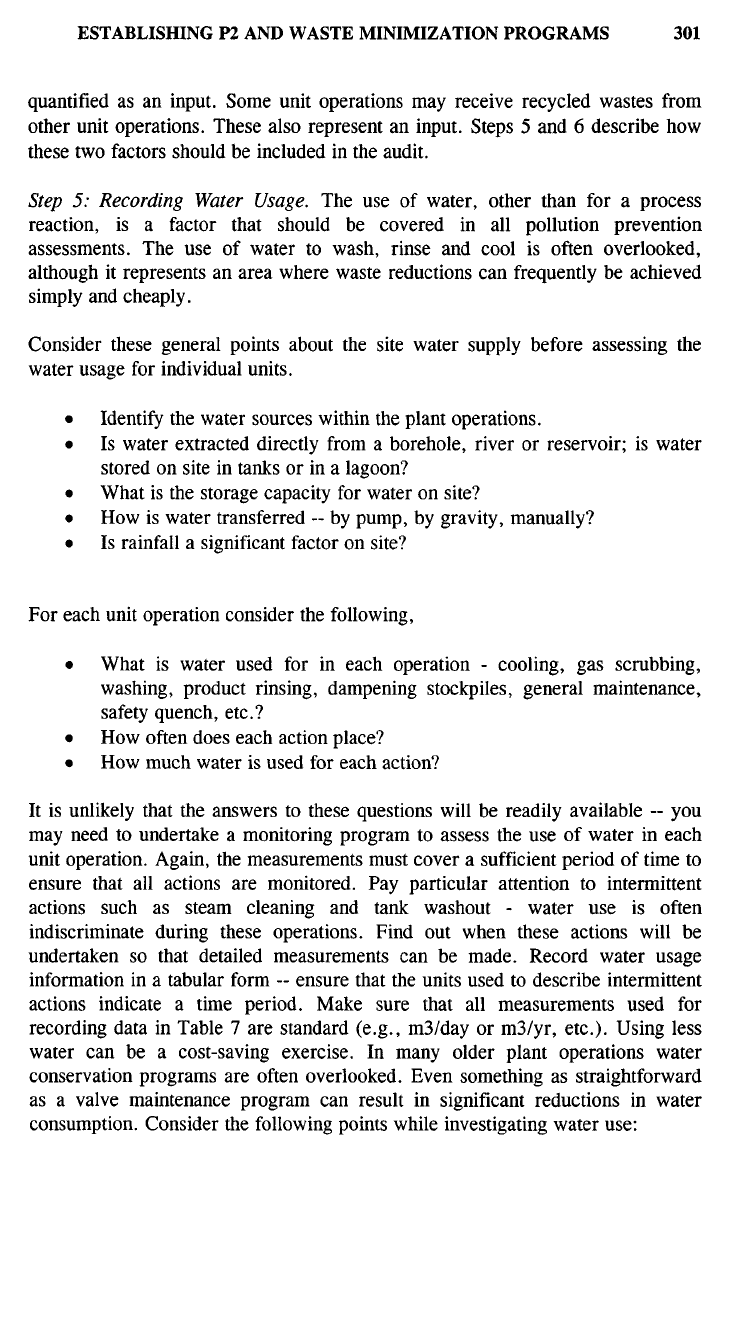
quantified as an input. Some unit operations may receive recycled wastes from
other unit operations. These also represent an input. Steps 5 and 6 describe how
these two factors should be included in the audit.
Step 5: Recording Water Usage. The use of water, other than for a process
reaction, is a factor that should be covered in all pollution prevention
assessments. The use of water to wash, rinse and cool is often overlooked,
although it represents an area where waste reductions can frequently be achieved
simply and cheaply.
Consider these general points about the site water supply before assessing the
water usage for individual units.
• Identify the water sources within the plant operations.
• Is water extracted directly from a borehole, river or reservoir; is water
stored on site in tanks or in a lagoon?
• What is the storage capacity for water on site?
• How is water transferred - by pump, by gravity, manually?
• Is rainfall a significant factor on site?
For each unit operation consider the following,
• What is water used for in each operation - cooling, gas scrubbing,
washing, product rinsing, dampening stockpiles, general maintenance,
safety quench, etc.?
• How often does each action place?
• How much water is used for each action?
It is unlikely that the answers to these questions will be readily available - you
may need to undertake a monitoring program to assess the use of water in each
unit operation. Again, the measurements must cover a sufficient period of time to
ensure that all actions are monitored. Pay particular attention to intermittent
actions such as steam cleaning and tank washout - water use is often
indiscriminate during these operations. Find out when these actions will be
undertaken so that detailed measurements can be made. Record water usage
information in a tabular form ~ ensure that the units used to describe intermittent
actions indicate a time period. Make sure that all measurements used for
recording data in Table 7 are standard (e.g., m3/day or m3/yr, etc.). Using less
water can be a cost-saving exercise. In many older plant operations water
conservation programs are often overlooked. Even something as straightforward
as a valve maintenance program can result in significant reductions in water
consumption. Consider the following points while investigating water use:
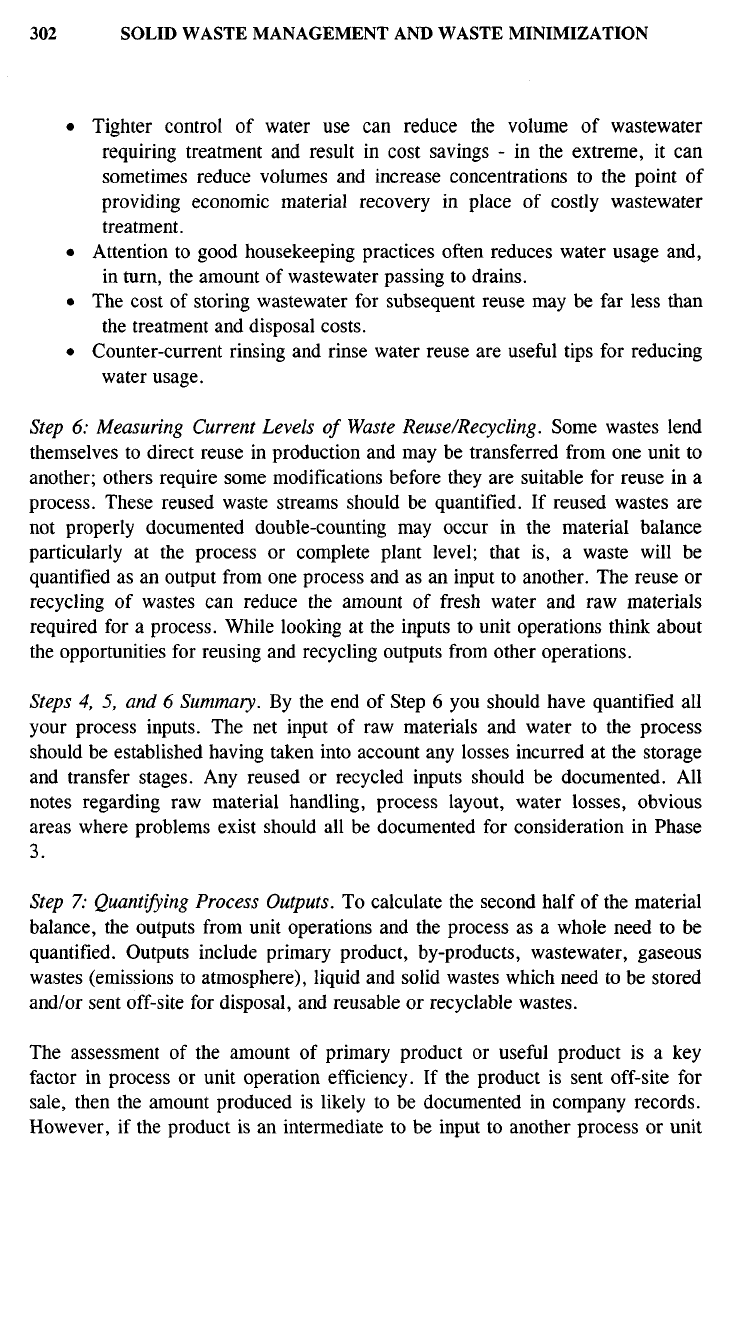
• Tighter control of water use can reduce the volume of wastewater
requiring treatment and result in cost savings - in the extreme, it can
sometimes reduce volumes and increase concentrations to the point of
providing economic material recovery in place of costly wastewater
treatment.
• Attention to good housekeeping practices often reduces water usage and,
in turn, the amount of wastewater passing to drains.
• The cost of storing wastewater for subsequent reuse may be far less than
the treatment and disposal costs.
• Counter-current rinsing and rinse water reuse are useful tips for reducing
water usage.
Step 6: Measuring Current Levels of Waste Reuse/Recycling. Some wastes lend
themselves to direct reuse in production and may be transferred from one unit to
another; others require some modifications before they are suitable for reuse in a
process. These reused waste streams should be quantified. If reused wastes are
not properly documented double-counting may occur in the material balance
particularly at the process or complete plant level; that is, a waste will be
quantified as an output from one process and as an input to another. The reuse or
recycling of wastes can reduce the amount of fresh water and raw materials
required for a process. While looking at the inputs to unit operations think about
the opportunities for reusing and recycling outputs from other operations.
Steps 4, 5, and 6 Summary. By the end of Step 6 you should have quantified all
your process inputs. The net input of raw materials and water to the process
should be established having taken into account any losses incurred at the storage
and transfer stages. Any reused or recycled inputs should be documented. All
notes regarding raw material handling, process layout, water losses, obvious
areas where problems exist should all be documented for consideration in Phase
3.
Step 7: Quantifying Process Outputs. To calculate the second half of the material
balance, the outputs from unit operations and the process as a whole need to be
quantified. Outputs include primary product, by-products, wastewater, gaseous
wastes (emissions to atmosphere), liquid and solid wastes which need to be stored
and/or sent off-site for disposal, and reusable or recyclable wastes.
The assessment of the amount of primary product or useful product is a key
factor in process or unit operation efficiency. If the product is sent off-site for
sale,
then the amount produced is likely to be documented in company records.
However, if the product is an intermediate to be input to another process or unit
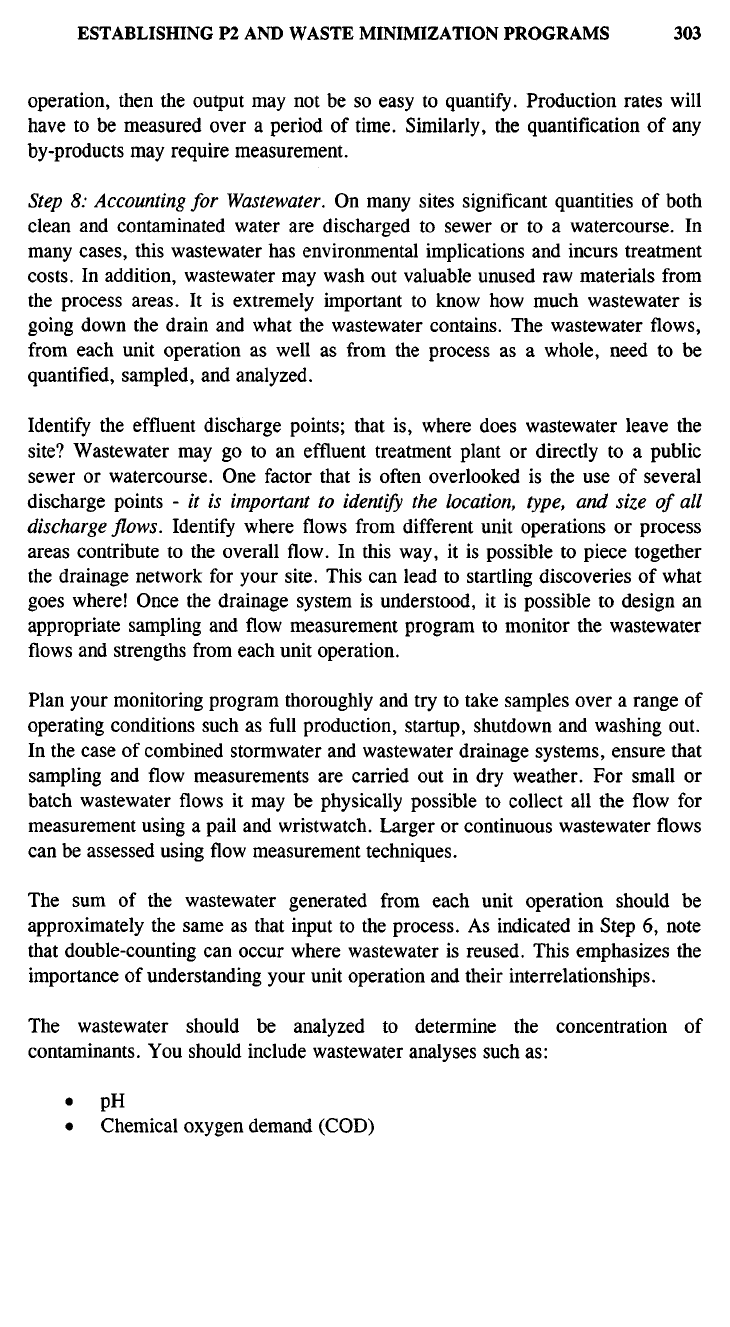
operation, then the output may not be so easy to quantify. Production rates will
have to be measured over a period of time. Similarly, the quantification of any
by-products may require measurement.
Step 8: Accounting for Wastewater. On many sites significant quantities of both
clean and contaminated water are discharged to sewer or to a watercourse. In
many cases, this wastewater has environmental implications and incurs treatment
costs.
In addition, wastewater may wash out valuable unused raw materials from
the process areas. It is extremely important to know how much wastewater is
going down the drain and what the wastewater contains. The wastewater flows,
from each unit operation as well as from the process as a whole, need to be
quantified, sampled, and analyzed.
Identify the effluent discharge points; that is, where does wastewater leave the
site? Wastewater may go to an effluent treatment plant or directly to a public
sewer or watercourse. One factor that is often overlooked is the use of several
discharge points - // is important to identify the location, type, and size of all
discharge flows. Identify where flows from different unit operations or process
areas contribute to the overall flow. In this way, it is possible to piece together
the drainage network for your site. This can lead to startling discoveries of what
goes where! Once the drainage system is understood, it is possible to design an
appropriate sampling and flow measurement program to monitor the wastewater
flows and strengths from each unit operation.
Plan your monitoring program thoroughly and try to take samples over a range of
operating conditions such as full production, startup, shutdown and washing out.
In the case of combined stormwater and wastewater drainage systems, ensure that
sampling and flow measurements are carried out in dry weather. For small or
batch wastewater flows it may be physically possible to collect all the flow for
measurement using a pail and wristwatch. Larger or continuous wastewater flows
can be assessed using flow measurement techniques.
The sum of the wastewater generated from each unit operation should be
approximately the same as that input to the process. As indicated in Step 6, note
that double-counting can occur where wastewater is reused. This emphasizes the
importance of understanding your unit operation and their interrelationships.
The wastewater should be analyzed to determine the concentration of
contaminants. You should include wastewater analyses such as:
• pH
• Chemical oxygen demand (COD)
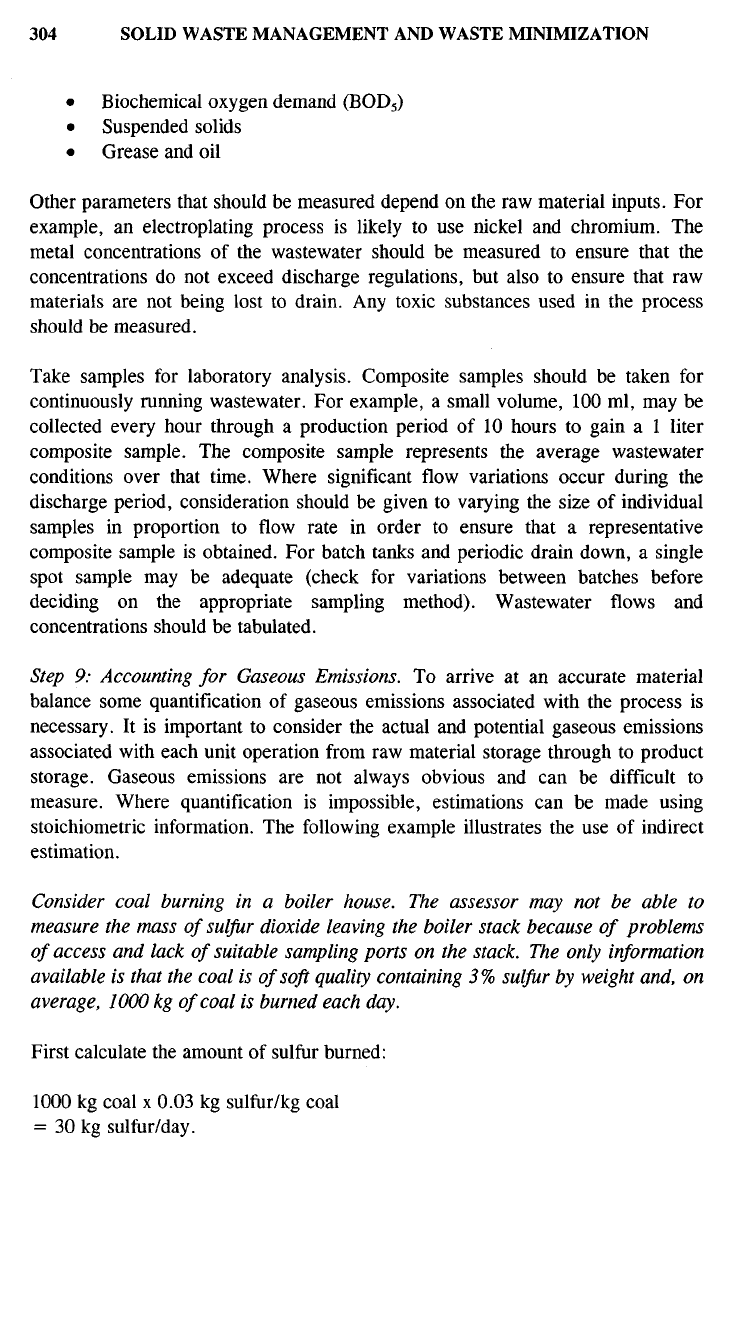
• Biochemical oxygen demand (BOD
5
)
• Suspended solids
• Grease and oil
Other parameters that should be measured depend on the raw material inputs. For
example, an electroplating process is likely to use nickel and chromium. The
metal concentrations of the wastewater should be measured to ensure that the
concentrations do not exceed discharge regulations, but also to ensure that raw
materials are not being lost to drain. Any toxic substances used in the process
should be measured.
Take samples for laboratory analysis. Composite samples should be taken for
continuously running wastewater. For example, a small volume, 100 ml, may be
collected every hour through a production period of 10 hours to gain a 1 liter
composite sample. The composite sample represents the average wastewater
conditions over that time. Where significant flow variations occur during the
discharge period, consideration should be given to varying the size of individual
samples in proportion to flow rate in order to ensure that a representative
composite sample is obtained. For batch tanks and periodic drain down, a single
spot sample may be adequate (check for variations between batches before
deciding on the appropriate sampling method). Wastewater flows and
concentrations should be tabulated.
Step 9: Accounting for Gaseous Emissions. To arrive at an accurate material
balance some quantification of gaseous emissions associated with the process is
necessary. It is important to consider the actual and potential gaseous emissions
associated with each unit operation from raw material storage through to product
storage. Gaseous emissions are not always obvious and can be difficult to
measure. Where quantification is impossible, estimations can be made using
stoichiometric information. The following example illustrates the use of indirect
estimation.
Consider coal burning in a boiler house. The assessor may not be able to
measure the mass of sulfur dioxide leaving the boiler stack because of problems
of access and lack of suitable sampling ports on the stack. The only information
available is that the coal is of soft quality containing 3% sulfur by weight and, on
average, 1000 kg of coal is burned each day.
First calculate the amount of sulfur burned:
1000 kg coal x 0.03 kg sulfur/kg coal
= 30 kg sulfur/day.
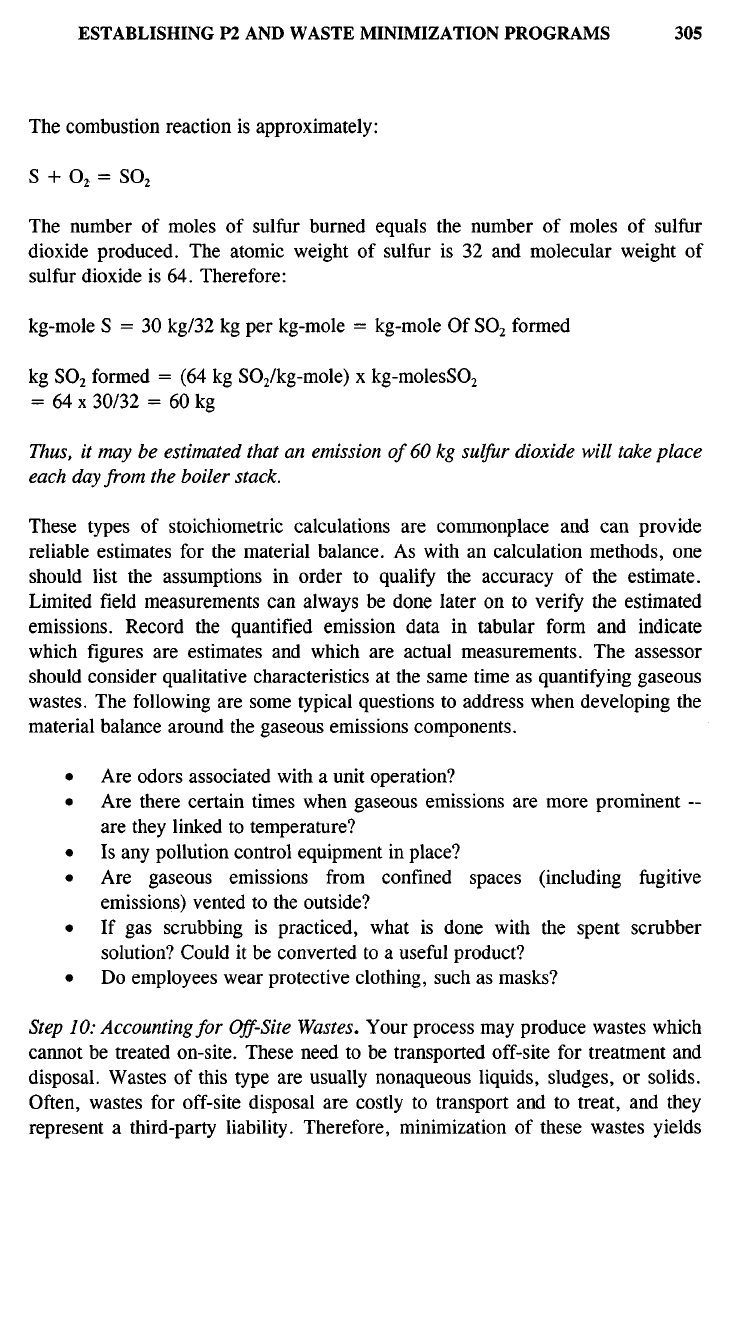
The combustion reaction is approximately:
S + O
2
= SO
2
The number of moles of sulfur burned equals the number of moles of sulfur
dioxide produced. The atomic weight of sulfur is 32 and molecular weight of
sulfur dioxide is 64. Therefore:
kg-mole S = 30 kg/32 kg per kg-mole = kg-mole Of SO
2
formed
kg SO
2
formed = (64 kg SO
2
/kg-mole) x kg-molesSO
2
= 64 x 30/32 = 60 kg
Thus, it may be estimated that an emission of 60 kg sulfur dioxide will take place
each day from the boiler stack.
These types of stoichiometric calculations are commonplace and can provide
reliable estimates for the material balance. As with an calculation methods, one
should list the assumptions in order to qualify the accuracy of the estimate.
Limited field measurements can always be done later on to verify the estimated
emissions. Record the quantified emission data in tabular form and indicate
which figures are estimates and which are actual measurements. The assessor
should consider qualitative characteristics at the same time as quantifying gaseous
wastes. The following are some typical questions to address when developing the
material balance around the gaseous emissions components.
• Are odors associated with a unit operation?
• Are there certain times when gaseous emissions are more prominent »
are they linked to temperature?
• Is any pollution control equipment in place?
• Are gaseous emissions from confined spaces (including fugitive
emissions) vented to the outside?
• If gas scrubbing is practiced, what is done with the spent scrubber
solution? Could it be converted to a useful product?
• Do employees wear protective clothing, such as masks?
Step 10: Accounting for Off-Site Wastes. Your process may produce wastes which
cannot be treated on-site. These need to be transported off-site for treatment and
disposal. Wastes of this type are usually nonaqueous liquids, sludges, or solids.
Often, wastes for off-site disposal are costly to transport and to treat, and they
represent a third-party liability. Therefore, minimization of these wastes yields
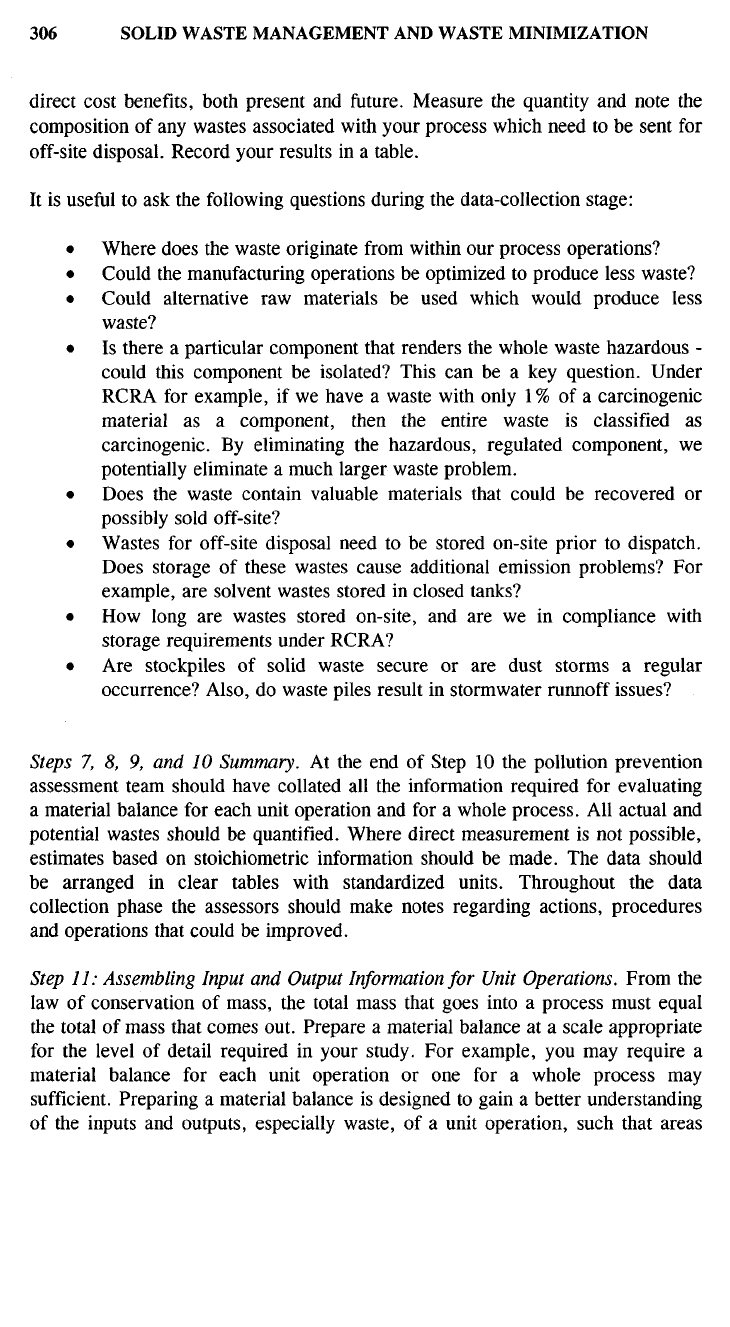
direct cost benefits, both present and future. Measure the quantity and note the
composition of any wastes associated with your process which need to be sent for
off-site disposal. Record your results in a table.
It is useful to ask the following questions during the data-collection stage:
• Where does the waste originate from within our process operations?
• Could the manufacturing operations be optimized to produce less waste?
• Could alternative raw materials be used which would produce less
waste?
• Is there a particular component that renders the whole waste hazardous -
could this component be isolated? This can be a key question. Under
RCRA for example, if we have a waste with only 1% of a carcinogenic
material as a component, then the entire waste is classified as
carcinogenic. By eliminating the hazardous, regulated component, we
potentially eliminate a much larger waste problem.
• Does the waste contain valuable materials that could be recovered or
possibly sold off-site?
• Wastes for off-site disposal need to be stored on-site prior to dispatch.
Does storage of these wastes cause additional emission problems? For
example, are solvent wastes stored in closed tanks?
• How long are wastes stored on-site, and are we in compliance with
storage requirements under RCRA?
• Are stockpiles of solid waste secure or are dust storms a regular
occurrence? Also, do waste piles result in stormwater runnoff issues?
Steps 7, 8, 9, and 10 Summary. At the end of Step 10 the pollution prevention
assessment team should have collated all the information required for evaluating
a material balance for each unit operation and for a whole process. All actual and
potential wastes should be quantified. Where direct measurement is not possible,
estimates based on stoichiometric information should be made. The data should
be arranged in clear tables with standardized units. Throughout the data
collection phase the assessors should make notes regarding actions, procedures
and operations that could be improved.
Step 11: Assembling Input and Output Information for Unit Operations. From the
law of conservation of mass, the total mass that goes into a process must equal
the total of mass that comes out. Prepare a material balance at a scale appropriate
for the level of detail required in your study. For example, you may require a
material balance for each unit operation or one for a whole process may
sufficient. Preparing a material balance is designed to gain a better understanding
of the inputs and outputs, especially waste, of a unit operation, such that areas
